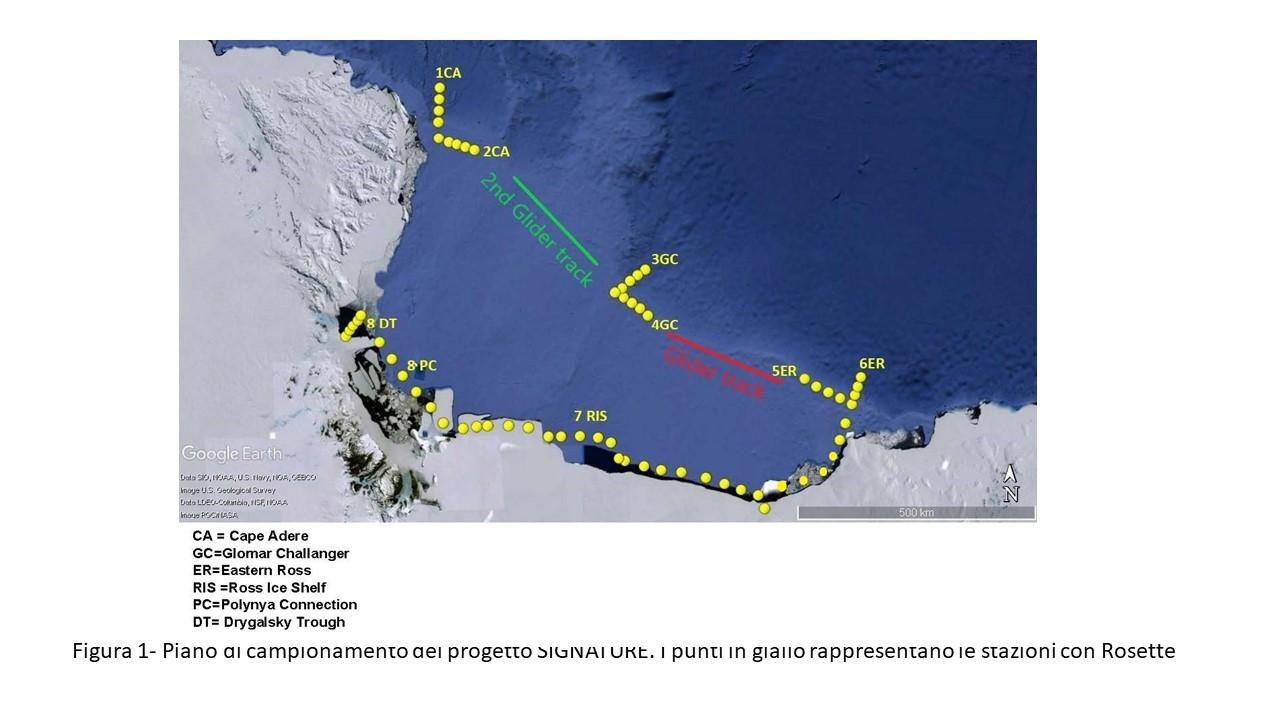- Acronym
- SIGNATURE
- Code
- PNRA19_00116
- Anno
- 2019
- Research area
- Marine science
- Specific research topic
- Bio-chemical-physical study of water masses produced in the Ross Sea.
- Region of interest
- The entire Ross Sea continental shelf, from west to east, including the Ross Ice Shelf
- PI
- Pierpaolo Falco
- PI establishment
- Università Politecnica delle Marche
- Institutional website
- https://www.univpm.it/Entra/
- Other institutions and subjects involved
- University of Genoa, Institute of Polar Sciences of the CNR section of Messina, National Institute of Oceanography and Experimental Geophysics of Trieste
- Consistency of the research team
- A total of 30 staff units including 21 men and 9 women divided as follows: Rec.temps: 17 Technicians: 4 Temp.det. researchers: 3 PhD students/post-docs: 5
- Project status
- In progress
- Main stations used
- Nave
- The project
The research activity proposed by the SIGNATURE project will focus on the physical-biogeochemical characterization of major Ross Sea water masses in several strategic sectors of the continental shelf. Through sampling that will take place over the entire Ross Sea (Figure 1), we aim to investigate the spatial and temporal variability of the water masses transiting the identified sectors and estimate the contribution to the formation of bottom waters (AABW). The overall goal is to provide a comprehensive assessment of the balance and variability of the water masses of interest (including both spatial and temporal scales) using numerical data and simulations.
- Images
-
- Motivation, importance of research
Antarctic Bottom Water (AABW) is the most voluminous body of water in the deep ocean and is the primary source of oxygen in the deep. The AABW is determined by the dense water formed on the Antarctic continental shelf resulting from severe winter cooling and frost release that occurs during sea ice formation. Ross Sea Bottom Water (RSBW), the second largest source of AABW, is formed by mixing along the continental slope of High Salinity Shelf Water (HSSW) and Circumpolar Deep Water (CDW).
Over the past 50 years, the salinity, density and volume of AABW have decreased, with the most dramatic changes observed in the Ross Sea. These changes have been attributed to increased melting of the Antarctic ice sheet.
Changes in RSBW characteristics depend on changes in shelf water (SW) properties in both source areas (Newfoundland Bay polynya and Ross Ice shelf polynya ) and export areas where SW mixes with CDW giving rise to AABW.
Changes in thermohaline properties or volume of dense sinking waters can result in changes in chemical properties, such as the amount of oxygen, CO2 and organic matter injected into the deep layers. The SIGNATURE project aims precisely to detail the characteristics of major water masses forming and leaving the Ross Sea with effects on abyssal stratification, large-scale deep circulation, and to ultimately provide new elements for climate simulations.
- Objectives of the proposal
1) Represent HSSW in the formation areas (TNBp and RIS polynya) to obtain new information on salinity trends and interannual variability;
2) Obtain salinity and temperature values of the HSSW in the export areas (mainly the Drygalsky and Glomar Challenger depressions) to evaluate the effects on AABW formation;
3) Check the observed fluctuations in salinity field from 1995 to 2018;
4) Investigate the flow of freshwater from the Amundsen Sea and entering the Ross Sea through the eastern sector;
5) Characterize the ISW formed beneath the RIS cavity;
6) Release a mooring at the margins of the continental slope of the Glomar Challanger Basin to describe the inflow and outflow of water masses (ISW and CDW) over time;
7) Determine the connection between TNBp and RIS polynya;
8) Set up and implement a long-term (1999-2020) simulation of Ross Sea ocean dynamics and a series of high-resolution ad hoc simulations (horizontal grid of 1 km or less) for process studies;
9) Study the distribution of different chemical parameters (O2 AT and pH, nutrients and particulate matter) to identify the most appropriate biogeochemical tracers of water masses in the areas i import and export of water masses;
10) Estimate prokaryotic biomass, activity and metabolism at different depths along the entire water column at the stations selected according to the sampling plan;
11) To shed light on the genomic potential of deep-sea microbial communities for organic matter processing with special attention to organic complexation of Fe
- Activities carried out and results achieved
The project has not yet begun
- Products
Mainly scientific articles
